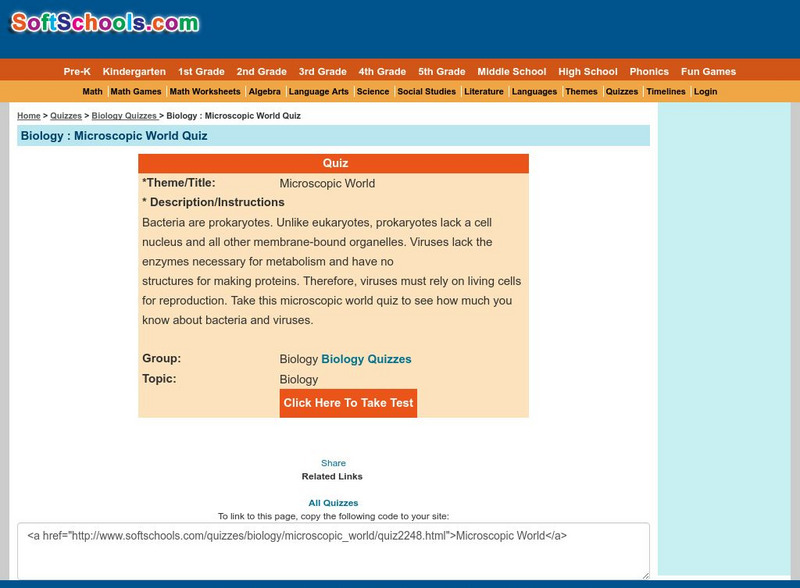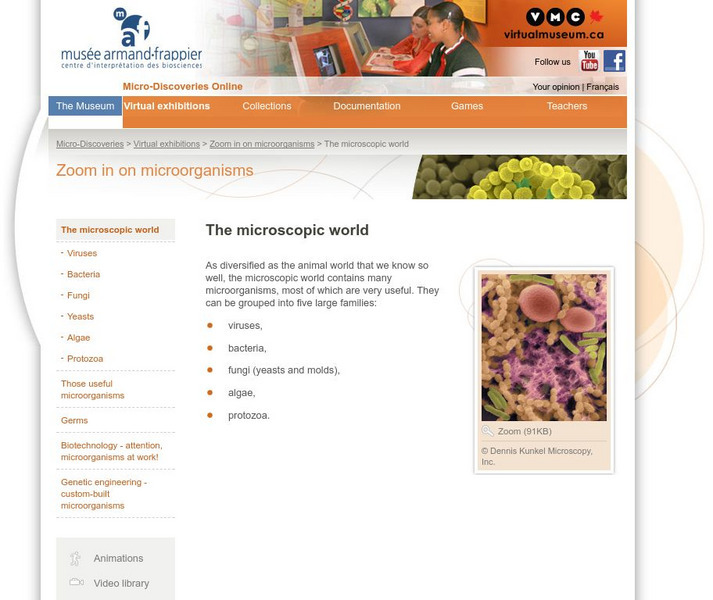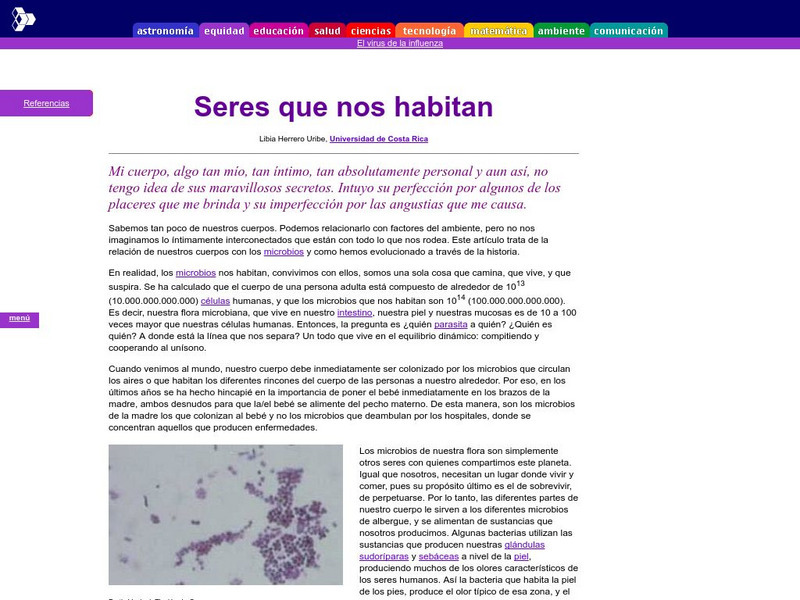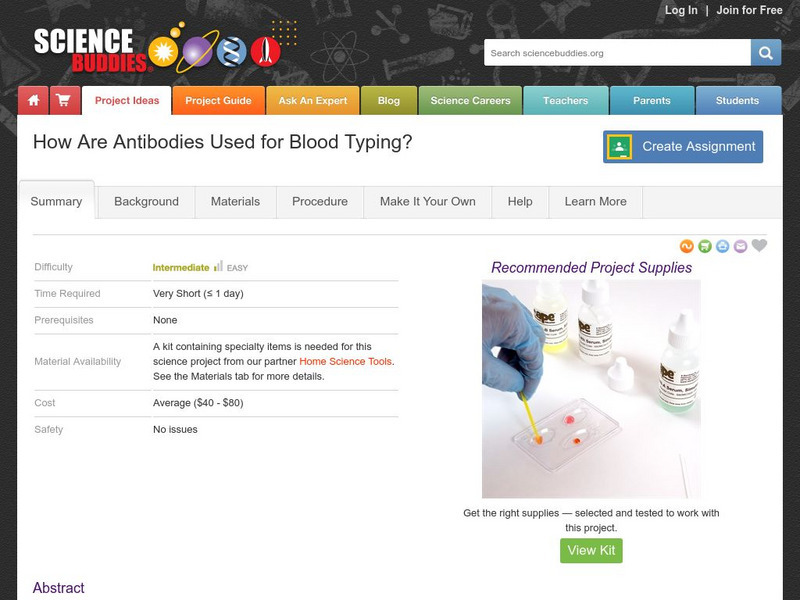Hi, what do you want to do?
Cells Alive
Cells Alive!
Animation studio that specializes in medical illustration lets you explore the structure and function of plant cells and animal cells, using videos and interactive graphics with clickable parts that lead to more detail.
The Association of the British Pharmaceutical Industry
Abpi: Infectious Diseases
A self-paced lesson on infectious diseases including bacterial, fungal, viral, and parasitic infections. Each disease featured discusses symptoms and treatment.
Discovery Education
Discovery Education: Curriculum Center: Science
The Discovery Channel provides numerous topics that are the most popular science topics taught in upper elementary and middle school. Content is organized by topics (Bacteria, Oceans, Solar System, etc.); all topics include quick facts,...
Curated OER
Kids Health: Immune System
If you've ever wondered how your immune system works, this movie and activity guide is for you! [7:26]
Soft Schools
Soft Schools: Microscopic World Quiz
Take this interactive, multiple-choice quiz over microorganisms, then review your score and any missed questions at the end.
Other
Armand Frappier Museum: Micro Discoveries Online: The Microscopic World
This comprehensive exhibit focuses on the wonders of microorganisms, what they are, how they can affect our daily lives, and how they can be manipulated. Videos, games, and animations are included. Teacher resource link explains each...
TED Talks
Ted: Ted Ed: How Pandemics Spread
A discussion about the globalization of disease, and the implications of a pandemic. Mark Honigsbaum describes the history of pandemics and how scientists can help prevent future outbreaks. [8:00]
TeachEngineering
Teach Engineering: Biosensors for Food Safety
How can you tell if harmful bacteria are in your food or water that might make you sick? What you eat or drink can be contaminated with bacteria, viruses, parasites and toxins pathogens that can be harmful or even fatal. Young scholars...
TED Talks
Ted: Ted Ed: How Do Germs Spread? Why Do They Make Us Sick?
Germs are found on almost every surface we come in contact with, which makes it incredibly common for our bodies to be exposed to them. But why are some of these germs relatively harmless, while others can be fatal? The creators of this...
BiologyWise
Biology Wise: Lytic Cycle
Explains what the lytic cycle of a virus is and the steps involved in the process.
American Academy of Family Physicians
Family doctor.org: Antibiotics
This article provides answers to several commonly asked questions about antibiotics. Several of the subjects that are covered include: what are antibiotics, how do they work, what is bacterial resistance, and how do I know when I need...
Fundación Cientec
Cientec: Seres Que Nos Habitan
This article is the relationship of our bodies with microbes and how we have evolved throughout history.
Nobel Media AB
The Nobel Prize: Wendell Stanley Biographical
This is a brief Nobel E-Museum biography on Wendell Meredith Stanley, the scientist and co-recipient of the 1946 Nobel Prize in Chemistry.Read about his education, as well as his contributions to various scientific studies through which...
Mayo Clinic
Mayo Clinic: Food Borne Illness
This site from MayoClinic.com provides great information on food-borne illness. The article is somewhat brief, but provides an excellent overview on the subject.
Estrella Mountain Community College
Online Biology Book: Control of Gene Expression
Online biology textbook illustrates the control of gene expression. Includes information on the role DNA plays in this study of science.
Annenberg Foundation
Annenberg Learner: Disease
Do you the factors that cause a disease to spread? In this simulation, figure out how to counter the spread of diseases!
CK-12 Foundation
Ck 12: Barriers to Pathogens
[Free Registration/Login may be required to access all resource tools.] In the following tutorial you will learn about the barriers that keep most pathogens out of the human body.
United Nations
United Nations Cyberschoolbus: Fighting Disease
The United Nations has distributed this list to make school age children aware of the communicable diseases that have most recently had an effect on society. Good descriptions are provided for each of the 11 diseases.
Ducksters
Ducksters: Biology for Kids: Infectious Disease
Kids learn about infectious diseases including pathogens such as viruses, bacteria, parasites, and fungi as well as transmission and other types of diseases.
Ducksters
Ducksters: Biology for Kids: Immune System
Study how the immune system helps to protect us against diseases and pathogens such as viruses, bacteria, and parasites.
ClassFlow
Class Flow: Germ Theory Jeopardy
[Free Registration/Login Required] This flipchart is a Jeopardy game where students will review and discuss the development of the Germ Theory, as well as cell organelles and bacterial and viral diseases.
Science Buddies
Science Buddies: How Are Antibodies Used for Blood Typing?
The human immune system has various ways of responding to an infection caused by bacteria or viruses. Our bodies produce proteins (antibodies) that are highly specific for the infectious agent as a part of our "humoral" immune response....
Khan Academy
Khan Academy: The Columbian Exchange
The rapid pace of globalization today is a continuation and acceleration of processes that began 500 years ago. This article discusses that not only humans started to travel the world, but also plants, species, bacteria, and viruses....
Cells Alive
Cells Alive!: How Big Is A
"Use this animation to compare the relative sizes of cells and organisms sitting on a pinhead. See the size of these nearly invisible without magnification" View dust mites dwarf pollen grains and human cells. In turn, bacteria and...


























